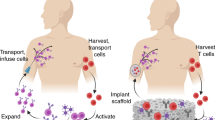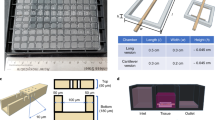Abstract
Low cost and high efficiency make disposable bioreactors feasible for small-scale therapeutic development and initial clinical trials. We have developed a cryogel-based disposable bioreactor matrix, which has been used for production of protein therapeutics such as urokinase and monoclonal antibodies (mAbs). The protocol discusses the application of a cryogel bioreactor for mAb production. Cryogels composed of either polyacrylamide (PAAm) coupled to gelatin or semi-interpenetrating PAAm-chitosan are synthesized by free-radical polymerization at −12 °C. Hybridoma cells are immobilized over the cryogel bioreactor and incubated for 48 h. Medium is circulated thereafter at 0.2 ml min−1 and bioreactors can be run continuously for 60 d. The cryogel-based packed-bed bioreactor can be formulated as a monolith or as beads; it also has an efficiency four times what can be obtained using a tissue-culture flask, a high surface-to-volume ratio and effective nutrient transport. After incubation, the bioreactor setup will take about 60 min using a pre-prepared sterilized cryogel.
This is a preview of subscription content, access via your institution
Access options
Subscribe to this journal
Receive 12 print issues and online access
$259.00 per year
only $21.58 per issue
Buy this article
- Purchase on Springer Link
- Instant access to full article PDF
Prices may be subject to local taxes which are calculated during checkout







Similar content being viewed by others
References
Chu, L. & Robinson, D.K. Industrial choices for protein production by large-scale cell culture. Curr. Opin. Biotechnol. 12, 180–187 (2001).
Jain, E. & Kumar, A. Upstream processes in antibody production: evaluation of critical parameters. Biotechnol. Adv. 26, 46–72 (2008).
Warnock, J.N. & Al-Rubeai, M. Bioreactor systems for the production of biopharmaceuticals from animal cells. Biotechnol. Appl. Biochem. 45, 1–12 (2006).
Eibl, R., Kaiser, S., Lombriser, R. & Eibl, D. Disposable bioreactors: the current state-of-the-art and recommended applications in biotechnology. Appl. Microbiol. Biotechnol. 86, 41–49 (2010).
Poles-Lahille, A. et al. Disposable bioreactors: from process development to production. BMC Proc. 5 (suppl. 8), P2 (2011).
Langer, E.S. Trends in perfusion bioreactors: next revolution in bioprocessing. BioProcess Int. 9, 18–22 (2011).
Meuwly, F., Ruffieux, P.-A., Kadouri, A. & von Stockar, U. Packed-bed bioreactors for mammalian cell culture: bioprocess and biomedical applications. Biotechnol. Adv. 25, 45–56 (2007).
Cadwell, J.J.S. New developments in hollow-fiber cell culture. Curr. Pharm. Biotechnol. 6, 397–403 (2005).
Bansal, V., Roychoudhury, P.K., Mattiasson, B. & Kumar, A. Recovery of urokinase from integrated mammalian cell culture cryogel bioreactor and purification of the enzyme using p-aminobenzamidine affinity chromatography. J. Mol. Recognit. 19, 332–339 (2006).
Jain, E., Karande, A.A. & Kumar, A. Supermacroporous polymer-based cryogel bioreactor for monoclonal antibody production in continuous culture using hybridoma cells. Biotechnol. Prog. 27, 170–180 (2011).
Kumar, A. et al. Integrated bioprocess for the production and isolation of urokinase from animal cell culture using supermacroporous cryogel matrices. Biotechnol. Bioeng. 93, 636–646 (2006).
Nilsang, S. et al. Monoclonal antibody production using a new supermacroporous cryogel bioreactor. Biotechnol. Prog. 23, 932–939 (2007).
Nilsang, S. et al. Three-dimensional culture for monoclonal antibody production by hybridoma cells immobilized in macroporous gel particles. Biotechnol. Prog. 24, 1122–1131 (2008).
Lozinsky, V.I. et al. Polymeric cryogels as promising materials of biotechnological interest. Trends Biotechnol. 21, 445–451 (2003).
Dainiak, M.B., Kumar, A., Galaev, I.Y. & Mattiasson, B. Detachment of affinity-captured bioparticles by elastic deformation of a macroporous hydrogel. Proc. Natl. Acad. Sci. USA 103, 849–854 (2006).
Plieva, F.M., Galaev, I.Y., Noppe, W. & Mattiasson, B. Cryogel applications in microbiology. Trends Microbiol. 16, 543–551 (2008).
Plieva, F.M. et al. Pore structure in supermacroporous polyacrylamide based cryogels. Soft Matter 1, 303–309 (2005).
Persson, P. et al. Characterization of a continuous supermacroporous monolithic matrix for chromatographic separation of large bioparticles. Biotechnol. Bioeng. 88, 224–236 (2004).
Jain, E. & Kumar, A. Designing supermacroporous cryogels based on polyacrylonitrile and a polyacrylamide-chitosan semi-interpenetrating network. J. Biomater. Sci. Polym. Ed. 20, 877–902 (2009).
Kumar, A., Plieva, F.M., Galaev, I.Y. & Mattiasson, B. Affinity fractionation of lymphocytes using a monolithic cryogel. J. Immunol. Methods 283, 185–194 (2003).
Kumar, A., Bansal, V., Andersson, J., Roychoudhury, P.K. & Mattiasson, B. Supermacroporous cryogel matrix for integrated protein isolation—immobilized metal affinity chromatographic purification of urokinase from cell culture broth of a human kidney cell line. J. Chromatogr. 1103, 35–42 (2006).
Roychoudhury, P.K., Khaparde, S.S., Mattiasson, B. & Kumar, A. Synthesis, regulation and production of urokinase using mammalian cell culture: a comprehensive review. Biotechnol. Adv. 24, 514–528 (2006).
Babac, C. et al. Binding of antibodies to concanavalin A–modified monolithic cryogel. React. Funct. Polym. 66, 1263–1271 (2006).
Deraz, S., Plieva, F.M., Galaev, I.Y., Karlsson, E.N. & Mattiasson, B. Capture of bacteriocins directly from non-clarified fermentation broth using macroporous monolithic cryogels with phenyl ligands. Enzyme Microb. Technol. 40, 786–793 (2007).
Williams, S.L., Eccleston, M.E. & Slater, N.K.H. Affinity capture of a biotinylated retrovirus on macroporous monolithic adsorbents: Towards a rapid single-step purification process. Biotechnol. Bioeng. 89, 783–787 (2005).
Srivastava, A., Shakya, A.K. & Kumar, A. Boronate affinity chromatography of cells and biomacromolecules using cryogel matrices. Enzyme Microb. Technol. 51, 373–381 (2012).
Kumar, A. et al. Affinity binding of cells to cryogel adsorbents with immobilized specific ligands: effect of ligand coupling and matrix architecture. J. Mol. Recognit. 18, 84–93 (2005).
Kumar, A. & Srivastava, A. Cell separation using cryogel-based affinity chromatography. Nat. Protoc. 5, 1737–1747 (2010).
Lozinsky, V.I. & Plieva, F.M. Poly(vinyl alcohol) cryogels employed as matrices for cell immobilization. 3. Overview of recent research and developments. Enzyme Microb. Technol. 23, 227–242 (1998).
Lozinsky, V.I., Plieva, F.M., Galaev, I.Y. & Mattiasson, B. The potential of polymeric cryogels in bioseparation. Bioseparation 10, 163–188 (2001).
Plieva, F.M. & Mattiasson, B. Macroporous gel particles as novel sorbent materials: rational design. Ind. Eng. Chem. Res. 47, 4131–4141 (2008).
Bhat, S., Tripathi, A. & Kumar, A. Supermacroprous chitosan-agarose-gelatin cryogels: in vitro characterization and in vivo assessment for cartilage tissue engineering. J. R. Soc. Interface 8, 540–554 (2011).
Bolgen, N. et al. Three-dimensional ingrowth of bone cells within biodegradable cryogel scaffolds in bioreactors at different regimes. Tissue Eng. Part A 14, 1743–1750 (2008).
Dainiak, M.B. et al. Gelatin-fibrinogen cryogel dermal matrices for wound repair: preparation, optimisation and in vitro study. Biomaterials 31, 67–76 (2010).
Tripathi, A., Kathuria, N. & Kumar, A. Elastic and macroporous agarose-gelatin cryogels with isotropic and anisotropic porosity for tissue engineering. J. Biomed. Mater. Res. A 90, 680–694 (2009).
Reddy, B.M., Karande, A.A. & Adiga, P.R. A common epitope of β-lactoglobulin and serum retinol-binding proteins: elucidation of its core sequence using synthetic peptides. Mol. Immunol. 29, 511–516 (1992).
Mo, J.A. & Holmdahl, R. The B cell response to autologous type II collagen: biased V gene repertoire with V gene sharing and epitope shift. J. Immunol. 157, 2440–2448 (1996).
Nandakumar, K.S. et al. Induction of arthritis by single monoclonal IgG anti-collagen type II antibodies and enhancement of arthritis in mice lacking inhibitory FcγRIIB. Eur. J. Immunol. 33, 2269–2277 (2003).
Favre, E., Pugeaud, P. & Peringer, P. Automated HPLC monitoring of glucose, glutamine, lactate and alanine on suspended mammalian cell reactors. Biotechnol. Tech. 4, 315–320 (1990).
McCullough, H. The determination of ammonia in whole blood by a direct colorimetric method. Clin. Chim. Acta 17, 297–304 (1967).
Plieva, F., Xiao, H.T., Galaev, I.Y., Bergenstahl, B. & Mattiasson, B. Macroporous elastic polyacrylamide gels prepared at subzero temperatures: control of porous structure. J. Mater. Chem. 16, 4065–4073 (2006).
Chisti, Y. & MooYoung, M. Bioprocess intensification through bioreactor engineering. Chem. Eng. Res. Des. 74, 575–583 (1996).
Stump, D.C., Thienpont, M. & Collen, D. Urokinase-related proteins in human urine—isolation and characterization of single-chain urokinase (prourokinase) and urokinase-inhibitor complex. J. Biol. Chem. 261, 1267–1273 (1986).
Lewis, L.J. Plasminogen activator (urokinase) from cultured cells. Thromb. Haemost. 42, 895–900 (1979).
Acknowledgements
We acknowledge the financial support from the Department of Biotechnology, Ministry of Science and Technology, Government of India; Protista Biotechnology Sweden; and the Swedish Research Council/SIDA Research Link Project. We are also thankful to all other co-workers, especially V. Bansal, S. Nilsang and B. Mattiasson who have contributed to the development of this work in one way or another. We also thank A. Karande for her kind help in providing the hybridoma cell lines and for mAb analysis.
Author information
Authors and Affiliations
Contributions
Both the authors (E.J. and A.K.) conceived, planned and conducted experiments on different aspects of this study. A.K. was responsible for supervising all the work described in this protocol.
Corresponding author
Ethics declarations
Competing interests
The authors declare no competing financial interests.
Supplementary information
Supplementary Methods
Determination of Monoclonal Antibody; Analysis of Glucose in spent media samples; Determination of Ammonia; Simultaneous Determination of Glucose, Lactic acid, and Glutamine by HPLC; and Determination of Urokinase Activity (PDF 369 kb)
Rights and permissions
About this article
Cite this article
Jain, E., Kumar, A. Disposable polymeric cryogel bioreactor matrix for therapeutic protein production. Nat Protoc 8, 821–835 (2013). https://doi.org/10.1038/nprot.2013.027
Published:
Issue Date:
DOI: https://doi.org/10.1038/nprot.2013.027
This article is cited by
-
Molecularly Imprinted Cryogels for the Selective Adsorption of Salicylic Acid
Applied Biochemistry and Biotechnology (2023)
-
Analysis of flow profiles and mass transfer of monolithic chromatographic columns: the geometric influence of channels and tortuosity
Brazilian Journal of Chemical Engineering (2020)
-
Cryostructurization of polymeric systems for developing macroporous cryogel as a foundational framework in bioengineering applications
Journal of Chemical Sciences (2019)
-
A simple method for the production of large volume 3D macroporous hydrogels for advanced biotechnological, medical and environmental applications
Scientific Reports (2016)
Comments
By submitting a comment you agree to abide by our Terms and Community Guidelines. If you find something abusive or that does not comply with our terms or guidelines please flag it as inappropriate.



